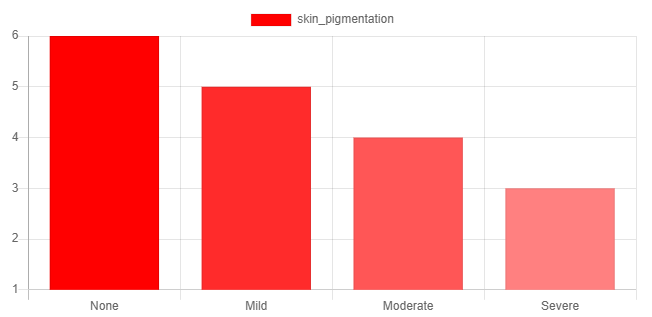Summary
For females, a non-pigmented skin (i.e., uniformity and intensity of skin color) is more attractive than a pigmented skin. The studies on skin appearance and attractiveness reveal key insights into how skin pigmentation affects attractiveness. Samson et al. (2010) found that clearer skin, which typically displays uniform pigmentation, is perceived as healthier and more attractive. Friedman (2005) discussed how aging affects skin elasticity and pigmentation, particularly through photoaging, supporting the idea that uniformly colored skin is more attractive due to its youthful appearance. Collectively, these studies underscore the significance of uniform skin pigmentation in enhancing perceived attractiveness and health. Furthermore, Van den Berghe and Frost (1986) discuss the evolutionary perspective, suggesting less pigmented skin may be part of a set of youthful traits favored in sexual selection, echoing Darwin’s views on the attractiveness of such traits.

Research
According to Samson et al. (2010) in their study titled “Visible skin condition and perception of human facial appearance“, changes in pigmentation are prominent indicators of skin aging, indicating that clearer skin, which typically means less pigmentation or uniform pigmentation, is perceived as healthier making it look better as compared to pigmented skin. In the Example of stimulus images from the study, image 3 shows the face with the smoothing of skin color variation. It reduce or eliminate variations such as redness, hyperpigmentation, or blotchiness, resulting in a more uniform skin tone, hence, showing that non-pigment skin is looking younger, healthier, and attractive.

As humans grow older, their facial skin undergoes several changes. According to Friedman (2005), it loses its elasticity and issues such as discoloration and uneven pigmentation become more prominent, often due to exposure to the sun, a process known as photoaging. This understanding supports the notion that non-pigmented, or uniformly colored skin, is often perceived as more attractive.

Additionally, Van den Berghe and Frost (1986) suggests that less pigmented skin in females may have evolved as part of a broader set of neotenous (youthful) traits that are perceived as attractive due to their association with youth and vitality. This perspective aligns with Charles Darwin’s observations in “The Descent of Man,” where he notes the evolutionary significance of certain physical traits, including skin color, in sexual selection.

References
Samson, N., Fink, B., & Matts, P. J. (2010). Visible skin condition and perception of human facial appearance. International Journal of Cosmetic Science, 32(3), 167-184. https://doi.org/10.1111/j.1468-2494.2009.00535.x
Friedman, O., 2005. Changes associated with the aging face. Facial plastic surgery clinics of North America, 13(3), pp.371-380. https://doi.org/10.1016/j.fsc.2005.04.004
Van den Berghe, P. L., & Frost, P. (1986). Skin color preference, sexual dimorphism and sexual selection: A case of gene culture co‐evolution?. Ethnic and Racial Studies, 9(1), 87-113. https://doi.org/10.1080/01419870.1986.9993516